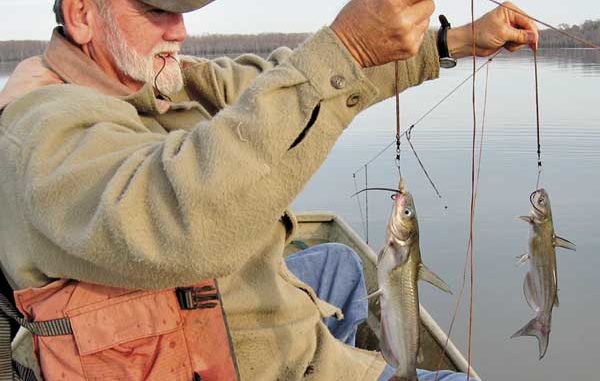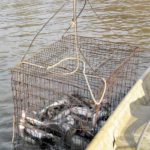
Follow this technique to load up a trotline with the sweetest meat ever to touch your tongue.
Admittedly, I haven’t set out a trotline for catfish in a really long time. The last time I remember stringing out a line, I was still in high school. Those of you who know me realize that this had to have happened a l-o-n-g time ago. I recall my brother and me stretching a line baited with small bream across a slough off Saline Bayou above the Salt Works near our home in Goldonna. We selected this spot for our fishing expedition because heavy rains had swelled the stream, making areas fishable that were little more than a trickle or a mudhole during normal water levels.
We ran the lines for three days straight as the water slowly fell, and caught catfish every night until receding water the third day left our bait high and dry.
The thing I recall about this venture was that the line was stretched across the slough with drops every few feet, leaving our baited hooks suspended somewhere between the surface and the bottom.
This proved to be an effective way to catch channel catfish, and is the method many trotliners use today. Most catfishermen use floats to suspend the main line far enough beneath the surface to avoid becoming entangled in the prop of a passing outboard motor but the baited hooks are well off the bottom.
I experienced trotlining for catfish recently with a totally different slant. Roy Dupree, my 60-year-old brother-in-law, takes into account that catfish are bottom feeders, and instead of suspending his lines, he lays the main line as well as the drops onto the muddy lake bottom.
Dupree lives with his wife, my sister Linda, on Clear Lake, which is the lower portion of the Black Lake/Clear Lake impoundment in Natchitoches Parish. Watching him run his trotlines is a lot like watching him pick peas. Motoring up to a small float, he lifts it with his boat paddle, pulls the line and drops off the bottom, and methodically begins taking off channel catfish.
“There’s really not a whole lot to it,” he said. “I have fished for catfish this way for more than 30 years, after observing and talking with some commercial fishermen. They told me they put their bait on the bottom and catch more fish this way, and it has worked well for me.”
I met Dupree at his home in mid-afternoon one chilly January day, and before we launched the boat, he reached in the refrigerator he keeps in an out-building, and dug out a box of Canadian night crawlers, better known as “cold worms.”
“I’ve learned that you don’t need but a little piece of bait to attract a catfish,” Dupree said as he cut each worm into 1-inch segments, sometimes getting from six to eight “baits” from a single worm.
“When you cut the worms, they can get pretty messy, so I dump some corn meal on them, which makes them easier to handle,” he said.
As we motored out to where his lines were set, I asked about the potential problem of snagging the lines on logs or stumps.
Shaking his head, Dupree said that in the area where he fishes, that doesn’t happen.
“I checked the lake bottom here where I fish, and it’s as clean as a parking lot,” he said. “I had to move my lines around some until I found this spot where there is no chance for the hooks to snag; there’s nothing there because this is just a big flat area, all about the same depth. However, the catfish seem to love to feed on the lake bottom on this flat.”
The area we fished was approximately 9 feet deep, but Dupree said the lake has yet to completely fill from a draw-down this past fall. He noted that when the lake is at normal levels, the water is usually around 11 feet deep.
Once the hooks were baited and dropped to rest in the mud overnight, we were done with the fishing preparation until the following morning.
The temperature the next morning was in the mid-30s, and I began to bundle up, assuming the normal thing to do was for us to head out before sunrise to run the lines.
“There’s no hurry; they’re not going anywhere. Let’s wait until it warms up a little,” Dupree said as he kicked back in his recliner and flipped on the Weather Channel.
After the sun had burned the frost off the boat seats, we headed back out to run the lines, which were identifiable by small plastic bottles used as floats. Again, it was a pea-picking operation. Dupree methodically moved from hook to hook, using a homemade device to expertly flip the fish off the hooks into the boat without touching a fish.
“I keep a foot-long piece of string in the boat that I use for that purpose,” he explained.
I watched as he looped the line around the shank of the hook, held each end between thumb and forefinger, letting the loop slide next to the fish’s mouth. A quick flip, and the fish was flopping in the bottom of the boat.
When we got back to his home an hour later, we counted our catch — 49 channel catfish virtually all the same size, 12 to 14 inches long. We also caught three gaspergou, which were released back into the lake.
After filleting the catfish, Dupree shared more of his secrets of trotlining for channel cats.
“I use nothing but close-weave nylon line,” he said. “I bought some loose weave once, and the hooks stayed fouled up in it. I don’t know if you can wear nylon out because I’ve used some of these same lines for 20 years. Lying on the bottom in the mud, they just don’t rot or wear out.”
Hooks, though, are another matter. Trial and error has shown Dupree that some hooks outlast others.
“I use nothing today but stainless steel hooks because they don’t corrode,” he said. “I use a size 1/0 stainless steel crappie hook. These hooks won’t hold a big fish, and I’ve had folks ask me why I didn’t go to a bigger size hook. I tell them because I’m not interested in catching big fish. I like these smaller fish because they’re so much better to eat. Catch any channel catfish over 3 pounds, and the taste changes. The bigger they are, the stronger they taste.”
Dupree, who is retired from the public school system, keeps his lines constantly baited because fresh catfish fillets on the plate are a requirement for his family.
He and Linda have three sons and daughters-in-law and six grandchildren, all living nearby, who depend upon the fruit of his trotlining for at least two fish fries a week.
“My grandchildren are constantly begging me to fry them some fish; I believe they’d rather have fish than steak, so it doesn’t take much arm-twisting for me to accommodate them,” he said.
The only time when trotlining is not an option for him is during the hot months of the year.
“Usually from June through August when oxygen levels are low in deeper water, the fish will die in a matter of minutes,” he said. “They feed on the bottom all year long, but during the summer months, they are constantly moving from the bottom up the water column where there is oxygen. When they’re on a hook on the bottom, they die quickly from lack of oxygen, so I don’t bait my lines then.”
Dupree is someone, in many ways, to be envied. He and his wife are both retired educators, they get to live on the lake and his deer hunting lease and duck blind are just minutes away. He recalled one day when he realized just how blessed he is.
“One morning awhile back when duck season was open, five of us went out to the duck blind and came back in a couple of hours with our limits of 30 ducks,” he recounted. “After cleaning the ducks, I got in my boat and ran my trotlines, and took off 98 catfish. After filleting them, I went and sat on my deer stand and shot a deer. If that’s not living, I don’t know what is.
“One thing about being retired and living on the lake with such good fishing five minutes away is that I don’t have to commit to a day-long fishing trip. I also fish for crappie, and have several secret brushpiles I regularly fish. If I feel the urge, I’ll go out, catch some crappie or bait my trotlines. I may be back napping in my recliner within an hour and then go back out another time or two during the day if I feel like it.
“After I retired, the principal would call me occasionally about coming in to substitute when a teacher was sick or something. I’d tell him to excuse me a moment; I first needed see if the wind was blowing. He finally stopped calling me,” Dupree said, chuckling, “after the first few times I turned him down because the weather was too good for me to pass up the chance to go fishing.”
I had the privilege of sitting at the table that night with the family, a table laden with french fries, hush puppies and absolutely the finest catfish fillets I have ever eaten.



